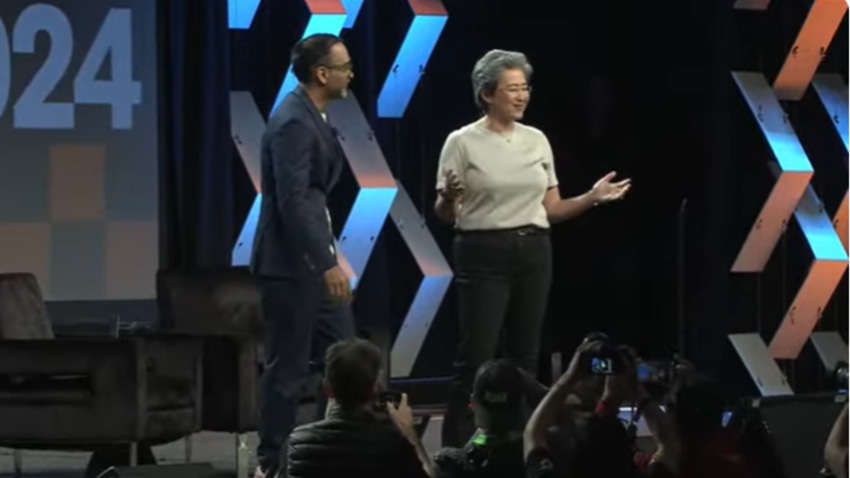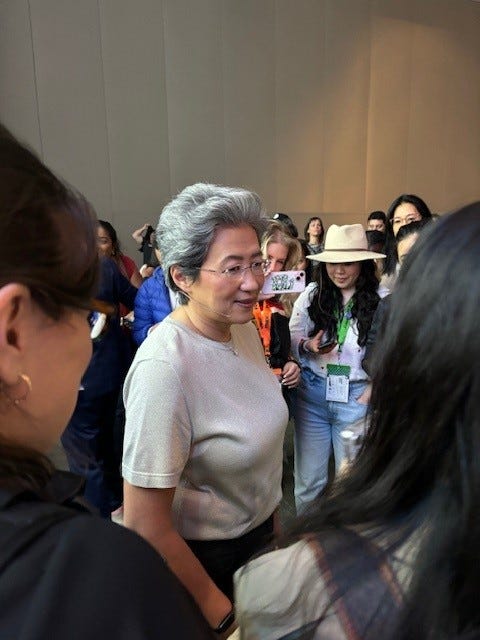AMD CEO Gets Down at SXSW 2024
Lisa Su even brought in a surprise guest, straight from the Academy Awards in Los Angeles

At a Glance
- AMD CEO Lisa Su let her hair down at SXSW 2024, showing a more personable side of her personality - in cowboy boots.
- She said the AI cycle is in its early stages, with room for several chipmakers to flourish. She showed off AMD's MI300 chip.
- Su invited a Hollywood friend: David Conley, whose firm was involved in the Oscar-winning animated short, 'War is Over.'
The version of Lisa Su who came out on stage in jeans, T-shirt and cowboy boots was decidedly not the usually serious, get-down-to-business AMD CEO that technologists recognize from past conferences.
Smiling broadly, relaxed and even a bit boisterous, Su welcomed attendees of SXSW 2024 to Austin, Texas. She has reason to do so: Su lives in Austin even though the semiconductor company she runs is based in Silicon Valley.
“Is this a great crowd?” said Su, to a roar of assent from the audience. “Wonderful, welcome to Austin!”

AMD CEO Lisa Su chatting with attendees, signing autographs, answering questions
The MIT graduate, who has helmed AMD for a decade, even brought a little bit of Hollywood glamor to SXSW: David Conley, whose firm was involved in the Oscar-winning animated short ‘War is Over,’ flew in after partying until 4:30 am at post-Oscar soirees the night before. His firm uses AMD chips.
AMD chips were also used in the production of Pixar’s ‘Elemental’ animated film and James Cameron’s Avatar 2. “Special effects require a tremendous amount of compute,” Su said.
Attendees also heard more about Su’s personal life. She described herself as a “nerd at heart” and her first job was doing “grunt” work at a semiconductor lab when chips were the size of a dime or quarter.
“I was in semiconductors when it wasn’t sexy,” she said. “I don’t know if it’s sexy now but it’s sexier.”
The dressed down Su is a more personable version of the tough CEO who is able to go toe-to-toe with Silicon Valley chieftains. Her rival and real-life cousin, Nvidia CEO Jensen Huang, is known for his trademark black leather jacket and a tattoo of Nvidia’s logo on his arm.
Catching up to Nvidia?
Asked if AMD can catch up to Nvidia, the market leader in GPUs that are widely used for AI processing, Su said there is room for several players.
“AI is really the most important technology in the next 10 plus years, but we’re so early in the current cycle,” she said. “I think you’re going to find that there’s no one size fits all.”
“We have a lot of respect for Nvidia,” Su added. “But we also have a lot of confidence in where we’re going.”
AMD launched its latest generative AI chip, the MI300, in December. Su said it has 153 billion transistors with 12 little chiplets stacked side by side and on top of each other to get the most power out of the chips.
Su said there is a shortage of compute right now but AMD is “really good at ramping up supply. … That’s what we’re working on.”
The next 10 years
“AI is the most important technology that has come on the scene over at least the last 50 years,” Su said. It is especially true with generative AI, when ChatGPT captured the public’s imagination worldwide.
“AI has always been around, but the ability to make AI so simple” to use such as with ChatGPT, she said, is only enabled by “a tremendous amount of computing power.”
In the next 10 years, Su predicted that AI will be “everywhere” – in data centers, at the edge and PCs.
Manufacturers are starting to roll out AI PCs in which the AI infrastructure sits on the device so data does not have to travel to the cloud and back.
AMD played a video where an AI PC using its Ryzen 8000 chip created an image using Stable Diffusion. The prompt was “a very cute bat eating tacos in Austin” – the bats under a downtown bridge are a tourist attraction in the city.
The image was generated in a few seconds. “You can see just how fast it is,” Su said. “This is on a local PC and you don’t have to pay anybody anything to run this.”
And the technology is only going to get better. The future of AI, she said, is “mind-blowing.”
About the Author(s)
You May Also Like


.jpg?width=700&auto=webp&quality=80&disable=upscale)
.jpg?width=700&auto=webp&quality=80&disable=upscale)
.jpg?width=700&auto=webp&quality=80&disable=upscale)
.jpg?width=300&auto=webp&quality=80&disable=upscale)
.jpg?width=300&auto=webp&quality=80&disable=upscale)
.jpg?width=300&auto=webp&quality=80&disable=upscale)
.jpg?width=300&auto=webp&quality=80&disable=upscale)
.jpg?width=300&auto=webp&quality=80&disable=upscale)